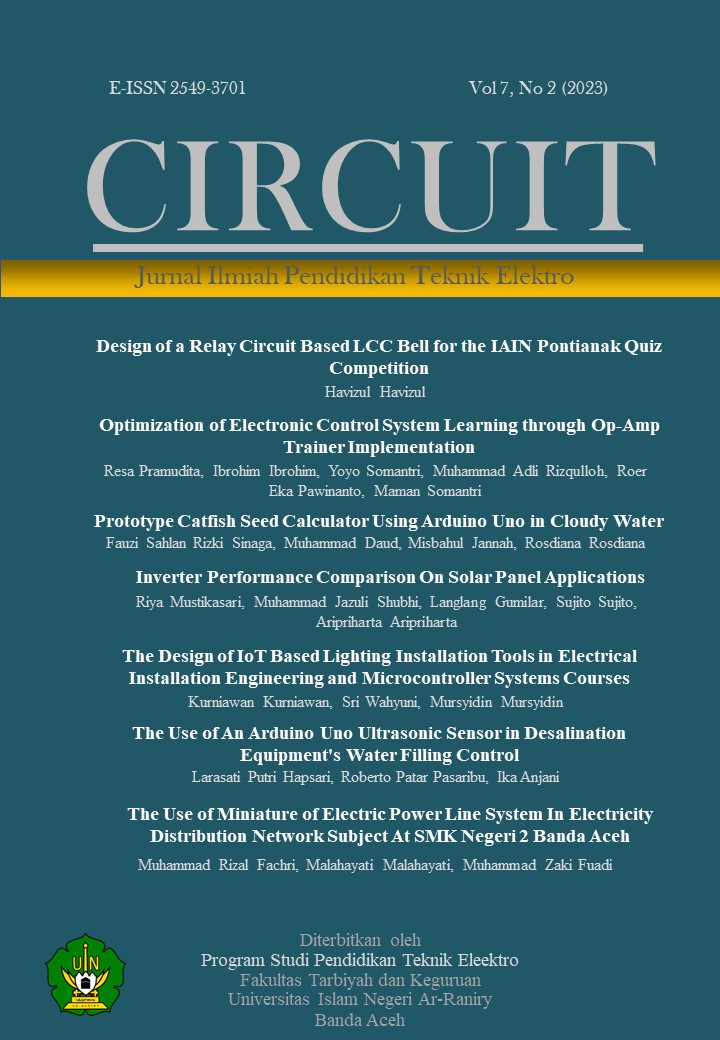IOT-Based Cultural Movement And Monitoring Systems With Renewable Energy Utilities
DOI:
https://doi.org/10.22373/crc.v7i2.16076Keywords:
Control, Monitoring, Renewable EnergyAbstract
The procedure of watering for and keeping track of the temperature and humidity levels in the room has a significant impact on the growth and productivity of oyster mushroom plants. It is often believed to be less effective and efficient because people in the Banyuwangi district perform the irrigation process conventionally with human aid. In order to construct digital businesses, artificial intelligence, cognitive technology, and (IoT) are being developed. People's daily lives are becoming more advanced and connected because to this transformation. This will encourage the creation of fresh innovations. Given this context, the idea to undertake research on the method of automatically and continuously monitoring watering (spraying) mushroom production using the Internet of Things (IoT) developed. In order to improve the effectiveness and productivity of mushroom cultivation, this instrument is designed with a temperature sensor (LM35) to monitor the humidity conditions of oyster mushroom plants. It is also fitted with a solar renewable energy system. In order to improve the effectiveness and productivity of mushroom cultivation, this instrument is designed with a temperature sensor (LM35) to monitor the humidity conditions of oyster mushroom plants. It is also fitted with a solar renewable energy system. The five steps of this study's execution were: a needs analysis; tool design; tool prototype; prototype testing; and conclusion. According to test results, the IoT-based control system for watering mushroom cultivation has an average error of 0.1% when measuring temperature and an average error of 2.66% when measuring humidity. This is almost perfect in terms of sensor readings, indicating that it can be used properly. While the success rate for the spray control system using the IoT system after five trials was 100%, the voltage, current, and power for solar panels were 17.60 V, 4.10 A, and 55.7 Watt at 14.00 during the day.
References
Aji, E. P., Wibowo, P., & Windarta, J. (n.d.). Kinerja Pembangkit Listrik Tenaga Surya ( PLTS ) dengan Sistem On Grid di BPR BKK Mandiraja Cabang Wanayasa Kabupaten Banjarnegara. 3(1), 15–27. https://doi.org/10.14710/jebt.2022.13158
Alfita, R., Joni, K., & Darmawan, F. D. (2021). Design of Monitoring Battery Solar Power Plant and Load Control System based Internet of Things. Teknik, 42(1), 35–44. https://doi.org/10.14710/teknik.v42i1.29687
Asep Hidayat, Sekar Agnia Ramdani, S. L. R. (2022). Pembangunan Pembangkit Listrik Tenaga Surya Di Waduk Cirata, Kabupaten Purwakarta. JIP : Jurnal Inovasi Penelitian, 3(6), 6701–6706.
Fathul Hadi, C. C. (2020). Prototype Sistem Control Berbasis Internet of Things Pada Penyinaran Kebun Buah Naga. CIRCUIT: Jurnal Ilmiah Pendidikan Teknik Elektro, 4(1), 56. https://doi.org/10.22373/crc.v4i1.6371
Hafiz Abdul, Fardian, & Rahman Aulia. (2017). Rancang Bangun Prototipe Pengukuran dan Pemantauan Suhu, Kelembaban serta Cahaya Secara Otomatis Berbasis Iotpada Rumah Jamur Merang. Rancang Bangun Prototipe Pengukuran Dan Pemantauan Suhu, Kelembaban Serta Cahaya Secara Otomatis Berbasis Iotpada Rumah Jamur Merang, 2(3), 51–57.
Liestyowati, D., Rachman, I., Firmansyah, E., & Mujiburrohman. (2022). Rancangan Sistem Pembangkit Listrik Tenaga Surya (PLTS) Berkapasitas 100 WP dengan Inverter 1000 Watt. INSOLOGI: Jurnal Sains Dan Teknologi, 1(5), 623–634. https://doi.org/10.55123/insologi.v1i5.1027
Miladinovic, I., & Schefer-Wenzl, S. (2018). NFV enabled IoT architecture for an operating room environment. IEEE World Forum on Internet of Things, WF-IoT 2018 - Proceedings, 2018-Janua, 98–102. https://doi.org/10.1109/WF-IoT.2018.8355128
Nurcahyani, E., Biologi, P. S., Lampung, U., Lampung, B., Studi, P., Terapan, B., Lampung, U., Lampung, B., Sari, B., Tengah, L., Tengah, L., & Tiram, J. (2022). Pelatihan Budidaya Jamur Tiram Untuk Peningkatan Pendapatan Petani di Desa Bandar Sari , Padang Ratu ,. 1(06), 664–670.
Rosmiah, R., Aminah, I. S., Hawalid, H., & Dasir, D. (2020). BUDIDAYA JAMUR TIRAM PUTIH (Pluoretus ostreatus) SEBAGAI UPAYA PERBAIKAN GIZI DAN MENINGKATKAN PENDAPATAN KELUARGA. Altifani: International Journal of Community Engagement, 1(1), 31–35. https://doi.org/10.32502/altifani.v1i1.3008
Setiawan, A., Suryadhianto, U., & Hadi, C. F. (2020). Sistem Monitoring dan Control Suhu Kelembapan Pada Jamur Tiram Berbasis Internet Of Thing ( IOT ). 02(01), 6–10.
Simarmata, R., Astuti, S., & Suharyono. (2022). Pengaruh suhu dan lama pengeringan jamur tiram putih (Pleurotus ostreatus) terhadap sifat kimia dan fisik tepung jammur tiram putih. Jurnal Agroindustri Berkelanjutan, 1(2), 198–208.
Sofwan, A., Wafdulloh, Y., Akbar, M. R., & Setiyono, B. (2020). SISTEM PENGATURAN DAN PEMANTAUAN SUHU DAN KELEMBAPAN PADA RUANG BUDIDAYA JAMUR TIRAM BERBASIS IoT (INTERNET OF THINGS). Transmisi, 22(1), 1–5. https://doi.org/10.14710/transmisi.22.1.1-5
Suryawati, E., Putra, R. A., & Taufik, H. (2019). Budidaya Jamur Tiram dan Olahannya untuk Kemandirian Masyarakat Desa Desa Seko Lubuk Tigo secara administratif berada di Kecamatan Lirik , Kabupaten Metode yang digunakan dalam kegiatan ini sesuai dengan diskusi tim abdi. 5(3), 358–370.
Susilawati, S., Suseno, S., & Rozikin, C. (2020). Sistem Monitoring Suhu Dan Kelembaban Ruang Produksi Berbasis Wireless Sensor Network Pada Pt. Xxx Manufacturing Services Indonesia. JUST IT : Jurnal Sistem Informasi, Teknologi Informasi Dan Komputer, 10(2), 136. https://doi.org/10.24853/justit.10.2.136-143
Trianda, Didi., Wahyuni, Sri., Mursyidin. (2022). Penerapan Modul Praktikum Instalasi Motor Listrik di SMKN 1 Darul Kamal. Circuit: Jurnal Ilmiah Pendidikan Teknik Elektro, 6(2), p.187-195
Yani, M., Yasi, R. M., & Hadi, C. F. (2021). Monitor Dan Aktuator Kandang Ayam. 03(02), 23–29.
Downloads
Published
Issue
Section
License
Authors who publish in this journal agree to the following terms:
- Authors retain copyright and grant the journal right of first publication with the work simultaneously licensed under a Creative Commons Attribution License that allows others to share the work with an acknowledgement of the work's authorship and initial publication in this journal.
The Journal uses license CC-BY-SA or an equivalent license as the optimal license for the publication, distribution, use, and reuse of scholarly works.
Authors are able to enter into separate, additional contractual arrangements for the non-exclusive distribution of the journal's published version of the work (e.g., post it to an institutional repository or publish it in a book), with an acknowledgement of its initial publication in this journal.
- Authors are permitted and encouraged to post their work online (e.g., in institutional repositories or on their website) prior to and during the submission process, as it can lead to productive exchanges, as well as earlier and greater citation of published work (See The Effect of Open Access).

